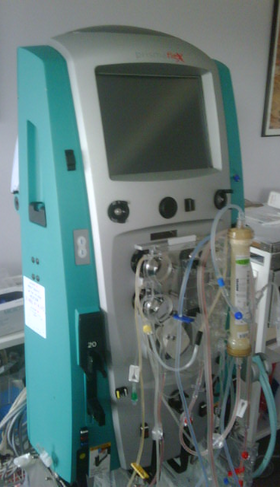Hemodiafiltration
| Hemofiltration | |
|---|---|
| Intervention | |

Hemofilter ready for use.
|
|
| Specialty | nephrology |
| ICD-9-CM | 39.95 |
| MeSH | D006440 |
In medicine, hemofiltration, also haemofiltration, is a renal replacement therapy which is used in the intensive care setting. It is usually used to treat acute kidney injury (AKI), but may be of benefit in multiple organ dysfunction syndrome or sepsis. During hemofiltration, a patient's blood is passed through a set of tubing (a filtration circuit) via a machine to a semipermeable membrane (the filter) where waste products and water (collectively called ultrafiltrate) are removed by convection. Replacement fluid is added and the blood is returned to the patient.
As in dialysis, in hemofiltration one achieves movement of solutes across a semi-permeable membrane. However, solute movement with hemofiltration is governed by convection rather than by diffusion. With hemofiltration, dialysate is not used. Instead, a positive hydrostatic pressure drives water and solutes across the filter membrane from the blood compartment to the filtrate compartment, from which it is drained. Solutes, both small and large, get dragged through the membrane at a similar rate by the flow of water that has been engendered by the hydrostatic pressure. Thus convection overcomes the reduced removal rate of larger solutes (due to their slow speed of diffusion) seen in hemodialysis.
Hemofiltration is sometimes used in combination with hemodialysis, when it is termed hemodiafiltration. Blood is pumped through the blood compartment of a high flux dialyzer, and a high rate of ultrafiltration is used, so there is a high rate of movement of water and solutes from blood to dialysate that must be replaced by substitution fluid that is infused directly into the blood line. However, dialysis solution is also run through the dialysate compartment of the dialyzer. The combination is theoretically useful because it results in good removal of both large and small molecular weight solutes.
...
Wikipedia
